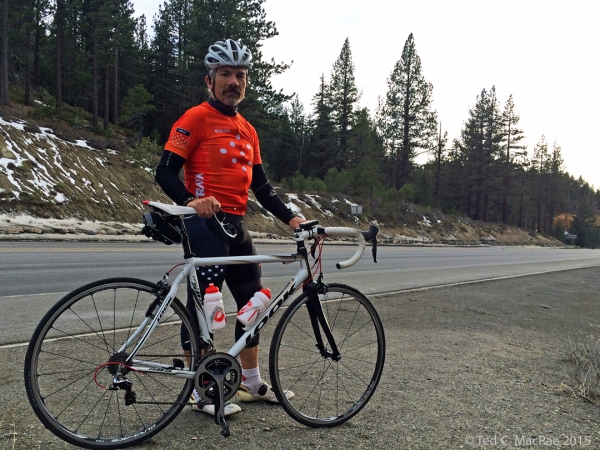We returned to Lake Tahoe for Spring Break this year—as we have done for the past eight years. Unlike past years, however, conditions were not good for skiing—California is now in its fourth year of an extended drought, and the snow pack in the mountains is down to 12% (12%!!!) of normal. Every cloud has a silver lining though, and what is not good for skiing is great for road cycling. I have done a fair bit of cycling around Lake Tahoe in past years, but snow and the desire to ski have always conspired to keep me from cycling to my heart’s content. Not this year! The lack of snow made it difficult to justify spending the money on lift tickets, and a weather forecast calling for sunny skies and high temperatures in the upper 50s to low 60s for the duration of our stay had me thinking this might be the year that I do my own personal “Tour of Lake Tahoe”—seven straight days of road riding through magnificent scenery and iconic climbs! Having my LOOK 585 Pro Team—newly rebuilt with Dura Ace 11-speed components and wheels and optimized for climbing—sealed the deal.
We arrived at the lodge in South Lake Tahoe on Saturday at mid-afternoon, and within an hour of checking in I was ready to ride. With temp in the low 60sF it was also a perfect opportunity to break out my new Strava Everest Climbing Challenge kit for its maiden voyage. The first day’s ride at Lake Tahoe is always about just getting reacquainted with the mountains, and starting as late in the day as I did I had to resist the temptation to do an ‘epic’ ride. I decided to take Hwy 50 up to Spooner Summit and back, which would be about a 25-mile ride. At 7150 ft, Spooner Summit is not the hardest climb around (although it definitely lets you know you are in the mountains!). I’d had a good week of training the week before, however, and with a full day of rest from the drive out here I had no trouble making it all the way up in one of the easier big chainring combos (52×23).

Spooner Summit (elev. 7150′)
At that point I had only ridden ~45 minutes, and I wasn’t quite ready to just turn around and go back. Instead, I decided to take Hwy 28 up north for the über-scenic descent to Sand Harbor State Park, then turned around and climbed back up to Spooner Lake. The climb to Spooner Lake on Hwy 28 is also not terribly difficult—a triple-step with two relatively easy steps bracketing a somewhat longer and harder middle step. I felt fine on that climb as well and was happy I’d decided to work another climb into the ride. The day, however, was growing short, and it was time to make a beeline back towards South Lake Tahoe before darkness made things too dangerous (I’d not thought to attach my headlight before the ride).

View across the lake from just south of Sand Harbor State Park
I’ve never been very comfortable on the Hwy 50 descent from Spooner Summit—traffic is heavy and fast, and even though there are four lanes, allowing me to take a full lane without worrying about blocking traffic, the winds coming up from the lake always seem to blow me around more than I’m comfortable with. This time was no exception, so I was a little more cautious than I like to be in some spots, but I hoped that after a week in the mountains I would find my descending nerve and be back to descending all out. Darkness descended quickly during the last part of the ride, so I got a pretty good workout keeping my speed up all the way back to the lodge. Stage 1 ended at 42.7 miles in 2:17:07 (avg speed 18.7 mph) with 3591 ft of climbing.
Tomorrow’s Stage 2 features more miles and two much harder climbs, neither of which I have done before—Luther Pass on Hwy 89 and the very difficult Kingsbury Grade on Hwy 207 back up and into the Lake Tahoe Basin!
© Ted C. MacRae 2015




